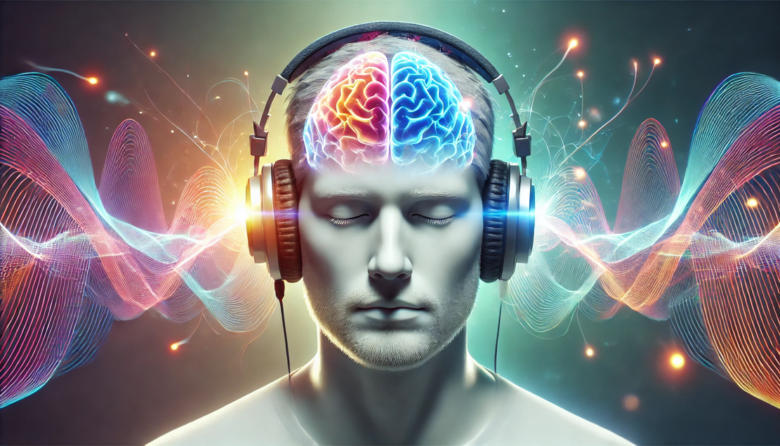In a world of digital distractions and mental stress, many people are finding binaural beats to be a simple, noninvasive tool for stimulating the brain. People claim that these rhythmic audio illusions can enhance focus, hack the brain, and facilitate meditation, sleep, and brain rewiring. Can two slightly different tones in each ear affect our brains? The idea seems too simple: put on your headphones, turn on some music, and let your brain listen in. Yet the idea is gaining traction, especially among those looking for natural remedies for anxiety, ADHD, and insomnia. Rewiring your brain through sound is intriguing, but is it science or a digital placebo? This article explores the research behind binaural beats and whether they can change your mind.
Understand the Science behind Binaural Beats:
Two slightly different frequencies in each ear create binaural beats. Your brain hears a third rhythmic pulse because of the difference between the two tones. If you hear 300 Hz in one ear and 310 Hz in the other, your brain will detect a heartbeat of 10 Hz. Natural brainwave states, including alpha (relaxation), beta (focus), theta (meditation), and delta (deep sleep), all occur at 10 Hz. By listening to these frequencies, your brain synchronizes with the heartbeats, putting you in the desired mental state. This phenomenon is brainwave synchronization. Although the principle is simple, it uses deep neurological processes. Scientists have studied how rhythmic patterns affect the auditory system and key brain areas related to attention, mood, and memory. They have found encouraging results that help relax the mind and improve cognitive skills.
Brainwave Synchronization Research:
Research into binaural beats has yielded conflicting but intriguing conclusions. Some studies suggest that alpha and theta binaural beats can help people relax, reduce anxiety, and improve mood. Alpha beats can relax people, while theta beats stimulate creativity and dreaming. Other studies indicate that alpha beats can improve attention, memory, and cognitive flexibility. Some experiments have shown that this synchronization does not produce significant changes.
One problem is that results vary depending on the listener’s baseline mental state, frequency, duration, and knowledge of the technology. The placebo effect is very prominent in neuroscience, especially in mental performance. Functional MRI and EEG data show that rhythmic audio stimulation changes brain activity. While it’s not magic, it’s not a myth either. Use binaural beats consistently and with mindfulness or intention.
Different Beats, Different States: The Power of Frequency
Choose a binaural beat frequency that suits your purpose, as each frequency range corresponds to a specific mental state. Delta waves (0.5-4 Hz) promote deep sleep and healing. Before bed, delta waves can help insomniacs fall asleep. Theta waves (4-8 Hz) are beneficial for meditation, intuition, and creativity. Theta waves can help artists, writers, and others explore themselves more deeply. Alpha waves (8-14 Hz) help you relax, stay calm, and stay alert after a busy day. Beta waves (14-30 Hz) are used by students and professionals to focus and think positively. Even less bright, gamma waves (above 30 Hz) are associated with mental clarity and awareness. With the clever use of binaural beats, a simple audio file can become a brain training tool.
Can Binaural Beats Reprogram the Brain?
Neuroplasticity—the reprogramming of the brain—occurs when new or strengthened neural pathways are created. Binaural beats can stimulate the reprogramming of the brain, but it doesn’t happen overnight. When used regularly in conjunction with meditation, affirmations, visualization, or mindfulness activities, binaural beats can increase the brain’s receptiveness to change. Think of them as fertile ground—listening to calm beats while practicing appreciation or focusing on a goal can help the brain make new emotional or cognitive connections. Over time, repeated patterns can form new brain connections. The beats can alter habits and lessen anxiety when paired with mindfulness. Binaural beats can promote neuroplasticity, but lasting change requires conscious commitment and consistency.
Tips for Effective Binaural Beats:
Binaural beats work best when used consciously. Put on your headphones first to ensure the frequencies reach your brain correctly. Theta waves are for meditation, delta waves for sleep, alpha waves for relaxation, and beta waves for productivity. Listen to them quietly, preferably when you can relax or focus. Start with 10–20 minutes at a time and build up as you get used to it. Many users report better sleep, improved focus, and reduced anxiety with regular use. Enhancing the effects can be achieved by combining listening with breathing exercises, writing, visualizing, or affirmations. As with any wellness tool, it is not a panacea. Consult a professional for serious mental health issues. Binaural beats can improve brain function naturally.
Conclusion:
Binaural beats are not magic, but they are not noise either. They tap into the brain’s amazing plasticity to promote relaxation, creativity, focus, and emotional balance. Early research and numerous anecdotal experiences show that using these tones consciously can provide significant benefits. Binaural beats are a calm, accessible way to improve sleep, meditation, or study. Remember, sustained activity and awareness make the greatest difference. When used correctly, binaural beats can be part of a mental health plan. The brain is constantly developing and learning, and a simple sound can help develop a rhythm.
FAQs:
1. Do binaural beats work without headphones?
For binaural beats, you need headphones with different frequencies for the left and right ears. Without headphones, the brain cannot create the necessary auditory illusions.
2. How long do I have to listen to binaural beats to see results?
Start with 10-20 minutes a day. Some people see results within a few days; others take weeks.
3. Can binaural beats reduce anxiety?
Yes, binaural beats using the alpha and theta frequencies are particularly effective. They are relaxing, calming, and they reduce anxiety over time.
4. Are there any dangers or negative effects?
Binaural beats are safe for most people. People with epilepsy or hypersensitivity to sound should consult a doctor before use. Make sure the volume is comfortable.
5. Can I use binaural beats for work or study?
Of course you can. Many people use beta or gamma beats to concentrate and work while doing mind-altering exercises.




